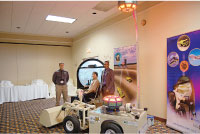 Mechatronics may be a technological enabler for mining in the future.
Mechatronics may be a technological enabler for mining in the future.
This was the key message presented at the 12th International Conference on Mechatronics in Sudbury from October 14 to 17. More than 100 researchers, engineers, practitioners, students and industry personnel representing countries from around the world had the opportunity to present their latest accomplishments. Sponsored by Barrick Gold and hosted by Laurentian University and Penguin Automated Systems Inc., the conference theme was Applications of Mechatronics to Natural Resources.
Defined as the integration of mechanical and electronic components controlled either remotely or by an operator, mechatronics is evident in automated machinery and tools throughout various industries.
Dr. Yassiah Bissiri, vice-director of Penguin Robotics and Automation Research Centre in Sudbury, gave a keynote on Mechantronics and the Future of the Natural Resource Industry. He described the strain of the world’s increasing population and its detrimental effects on our finite resources.
"We are running out of solutions," he said. "Gold will be gone. Nickel will be gone. So we need to look to technology such as mechatronics… to go to places people can’t get to."
With 71 per cent of the Earth’s surface underwater, Bissiri suggested there is a need to create a technology for underwater exploration and mining to tap into resources that, until now, have been inaccessible.
Bissiri spoke of several research projects in development at the centre, including a wireless optical communication system for underwater using submersible solid-state robots.
Dr. Greg Baiden, Canadian research chair in robotics and mine automation, explained the project.
"The two things together allow you to create the ability to run robots at extreme depths underwater, much the same as you’d mine with a fleet of equipment here and teleoperate them from surface, so people don’t have to go there. Therefore, you make them small enough and solid state enough to work in those environments."
The beauty of the wireless optical communication sysyem is that it eliminates radio and tethers. Radio control has limited bandwidth for transmitting clear video signals and it doesn’t work underwater. Tethers restrict movement. Dan McConnell, Penguin Automated Systems electronics technician, said light transmits video signals underwater better than sonar. Although the system is still in the research phase, Baiden said they are currently working with companies using the technology for data collection.
Andrew Scott, Barrick Gold’s director of mining, innovation and technology, sees the use of mechatronics as a key enabler in the mining industry.
"We see this as being very strategic from a technology perspective," Scott said, emphasizing that mechatronics is not a new practice, but simply the union of different specialties. "This is more about investing in the future and putting ourselves in a good position, not just Barrick as a company, but the industry."
Scott found the collaboration and networking opportunities beneficial. The conference brought to light similar projects being undertaken by different international research organizations.
"If they are aware of each other, then they could probably maximize even more value by reducing duplication and costs of invention, and potentially accelerate it. I think that was a key take away from the conference."

